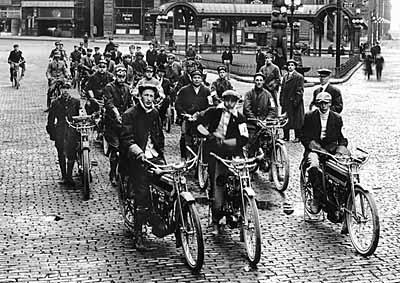VINTAGE BIKES TO SQUARE OFF
Pope, Sears, Flying Merkel, Excelsior, Henderson, Indian, Triumph, and the Harley-Davidson’s Silent Grey Fellows. These are just some of the vintage, pre-1916 two-wheelers that will be thumping their way across the United States when the Motorcycle Cannonball endurance run kicks off on 10 September.
Riders will virtually dip their tread in the salty waters of the East Coast’s Atlantic Ocean as the officials wave the green flag then come to rest some 5300km later at Pacific Ocean’s West Coast.
Usually on display in museums, private collections, or in Harley-Davidson dealerships, packs of antique motorcycles will leave their prestigious perches and hit the road, being put to the test during this gruelling coast-to-coast pursuit as their riders navigate the back roads and byways of America.
Some motorcycles will be built specifically for this challenge in accordance to the event’s stringent qualifying rules. Many may not complete the ride and the drama will build as the course will determine how many will, indeed, finish.
Following along the paths of their forefathers, each of the riders and their machines will be pushed to the very limit as the procession rolls from Kitty Hawk in North Carolina to Santa Monica, California, during the two-week odyssey.
A route to remember
Cannonball’s course master John Classen has painstakingly mapped out a route for the hearty men and women motorcyclists that squarely addresses the nuances of this ride.
“Our route was chosen to avoid having the riders enter a single interstate highway whereever possible. We’ll have 12 hours of daylight each day and a goal of having every rider check in at the day’s ending point one hour before sunset,” he said.
“We don’t want anyone having to deal with the safety issues of meeting up with the local wildlife after dark, and we are expecting some breakdowns.”
Classen is well aware of the ins and outs of these types of contests. With over 20 years experience directing various motor sport competitions and personal experience as a navigator in the Great Race for five years (where he won the title of Champion Navigator for the race in 1984), John knows his way around a route.
In March, he personally drove the coast-to-coast course for the Motorcycle Cannonball in the first of two pre-run trips to produce precise driving instructions for entrants and to smooth out any wrinkles along the way.
Shaping up for a seriously taxing ride
While each competitor in this unique event is obviously enamoured with his or her motorcycle and the history it contains, few have actually ridden a course of this magnitude, let alone on a 95-year-old+ machine.
Contestants are from all walks of life and include museum owners, authors, and collectors as well as restorers, builders, mechanics, and an Iron Butt rider. Some of the participants come from as far afield as the Britain and Germany. Many have subjected themselves to rigorous training in order to endure the harsh physical demands the ride will require.
The Motorcycle Cannonball, named after the famed Erwin “Cannonball” Baker, who set 143 driving records from 1910 through the 1930s, dares contestants to live up to the records set by men like Baker. Setting his first record on an Indian motorcycle in 1914, Cannonball made the coast-to-coast ride in 11 days.
For the 2010 ride, some of the same challenges face riders that concerned their brave forefathers: gas availability, machine’s performance, and physical strength. Nothing was then, nor will be now, taken for granted as the modern-day motorcyclists measure themselves against many of the USA’s most beloved and respected motorcycling ancestors.
This spectacular event is an opportunity of a lifetime for all its participants. Lonnie Isam, Jnr, promoter and owner of Jurassic Racing in Sturgis, South Dakota, is looking forward to the ride. He admits that the most he’s ever logged on a pre-1916 in a day is about 80km, so he’s aware that there’s a real challenge ahead of him to cover the daily 400km average distance during the Cannonball ride.
“You know, this started out as just a bunch of guys wanting to go for a ride that we’d been planning out over the years, maybe 15 or 16 of us. Then everybody started hearing about it and wanted to get in on it and it just grew,” he explains.
Now, facing a full field of vintage motorcycles and anxious riders preparing to hit the wide-open road, the gauntlet has been thrown.
Ladies and gentlemen, fasten your kidney belts. It’s going to be an exciting, historical, and decidedly bumpy ride.
